5 Stretching Exercises for Seniors—or Anyone Who Feels Achy
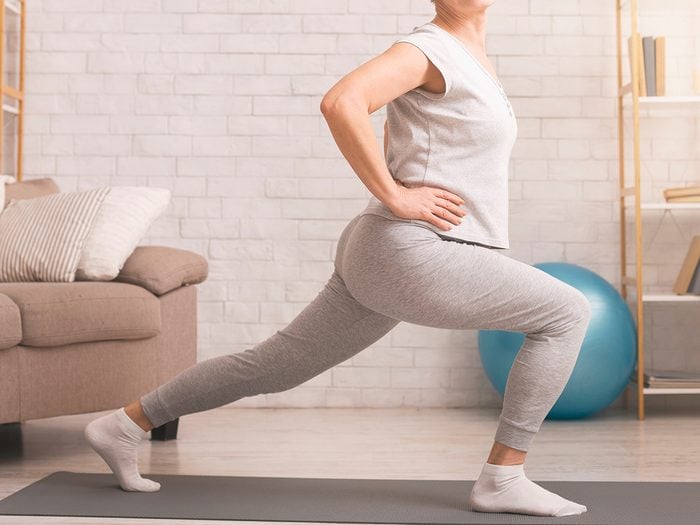
Keep your body limber and supple at any age with these full-body stretches. Plus, learn the benefits of stretching as you grow older.
We all like to joke about our aching, aging bones and the way our bodies set off a symphony of groans when we rise in the morning. And for a lot of us, getting older does, in fact, mean getting, er, creakier. But while it’s easy to assume that taking a few (or a lot) more trips around the sun automatically equates to a stiffer, less-limber body, that’s not strictly true.
“Many aging adults believe that reduced range of motion or stiffness is normal when in fact, soft tissues—including muscles and connective tissue—and joints can be conditioned to possess properties such as mobility and resiliency,” says Ryan Glatt, a personal trainer and brain health coach for the Pacific Neuroscience Institute at Providence Saint John’s Health Center in Santa Monica, California.
(Related: 9 Ballet Stretches to Do for 10 Minutes a Day to Improve Your Flexibility)
Stretching for seniors
Staying fit through all of life’s stages can stave off many of the mobility-related problems that are often viewed as part and parcel of getting older. “Stretching can be helpful in preventing injuries, managing muscle soreness, and allowing for participation in a variety of exercises and physical activities,” says Glatt. Plus, he points out, a regular stretching routine, especially when completed as part of a full exercise program, can be a mental health booster, reminding you to take time to breathe, relax, and socialize with others.
Of course, even if you’ve been active your whole life, that doesn’t mean you’ll automatically be “saved” from age-related mobility concerns. For instance, if you had an injury earlier in life, scar tissue, arthritis, or inflammation may result in limited mobility. Likewise, the cartilage in joints can wear down with use and time, which can also contribute to pain, stiffness, or discomfort.
No matter where you fall on the sliding scale of mobility, you can work to maintain or improve your flexibility, regardless of your age. So if you’re starting to feel creakier when you get out of bed or have noticed you just can’t move the way you once did, there’s no time like the present to add a daily stretching routine to your schedule.
(Related: 5 Stretches for Upper Back Pain)
Stretching is part of a whole
While a variety of types of stretching plays an important part of maintaining flexibility as you get older, that’s not the only factor when it comes to keeping your joints pliable and healthy. In fact, staying active, in general, is vitally important to flexibility and mobility. “Generally, as we age, we become more settled,” says personal trainer Brett Durney, cofounder of Fitness Lab, which operates boutique personal training gyms in London. “We have an easier lifestyle in which movement tends to decrease.”
Maybe your steady job has you behind a desk for upwards of eight hours a day. Or maybe your lifestyle doesn’t make walking or public transit all that necessary. Over time, these small habits that reduce total daily activity end up adding up—and not in a good way. “They add up and contribute to decreased flexibility, decreased strength, and decreased overall health,” Durney says. Which is why, when it comes to staying agile, you need to do more than check off stretching from your weekly to-do list. You need to think about staying active on a whole.
(Related: 4 Expert Tips You Need to Know to Stretch Properly)
Don’t ditch the cardio and strength training
Specifically, Durney emphasizes the need to include cardio-based lifestyle activities in a daily routine. Think about it: activities like walking, swimming, playing tennis, or taking a group exercise class are all going to get your heart rate up and your blood flowing. Plus, you’ll be moving major joints and muscle groups through a full range of motion, which helps keep those joints performing at their peak.
And when you add resistance training to your routine? You’re bolstering your movement patterns and total body strength while also boosting flexibility. “Take a squat, for example,” Durney says. “You have to move your hips through a full range of motion, which improves mobility that translates to important daily activities, like getting up from a chair.”
All in all, aim to do cardio exercises, like walking, for at least 30 minutes a day, most days of the week. Then add a 20- to 30-minute strength-training routine to your schedule two to four days a week. These two factors play important roles in overall health and are excellent ways to maintain flexibility and mobility. Bonus: there are a ton of cardio- and strength-based exercises you can do at home at any age.
(Related: You’d Be Surprised At What Actually Counts As Cardio)
Still, stretching is pretty important
While cardio and strength training are certainly foundational activities for maintaining overall mobility, stretching is an important way to target specific joints to work on improving range of motion. Over time, you may find that you regain, or even improve, your flexibility in areas where you’ve noticed a decline. That is why regular stretching should be part of everyone’s fitness routine. It doesn’t just offer short-term comfort and relief (though those are much appreciated). It can lead to long-term lifestyle benefits.
(Related: 4 Quad Stretches Everyone Should Know)
Stretching exercises for seniors
When starting a stretching plan, be sure to target all of your major muscles and joints. Consider adding the following movements, provided by Durney, into your regular routine.
Lumbar rotation: Do it first thing in the morning
Consider the lumbar rotation a comforting morning stretch. When you wake up from a good night’s rest, your body likely feels a little stiffer than it does after you’ve been up and moving around. Help wake up your back by performing the lumbar rotation.
Sit upright on your bed, your feet flat on the floor and your knees and hips bent at 90-degree angles. Roll your shoulders back and look straight ahead, focusing on your posture.
Place your left hand on the bed, behind and to the outside of your left hip. Place your right hand on your right knee.
Take a deep breath in, lifting and expanding your chest and creating space along your spine. As you exhale, rotate your shoulders to the left and look behind you, twisting your spine as you keep your hips steady.
Hold the position for five seconds. Release and return to centre before repeating the movement to the right. Perform a total of five twists to each side.
(Related: 4 Calf Stretches Everyone Needs)
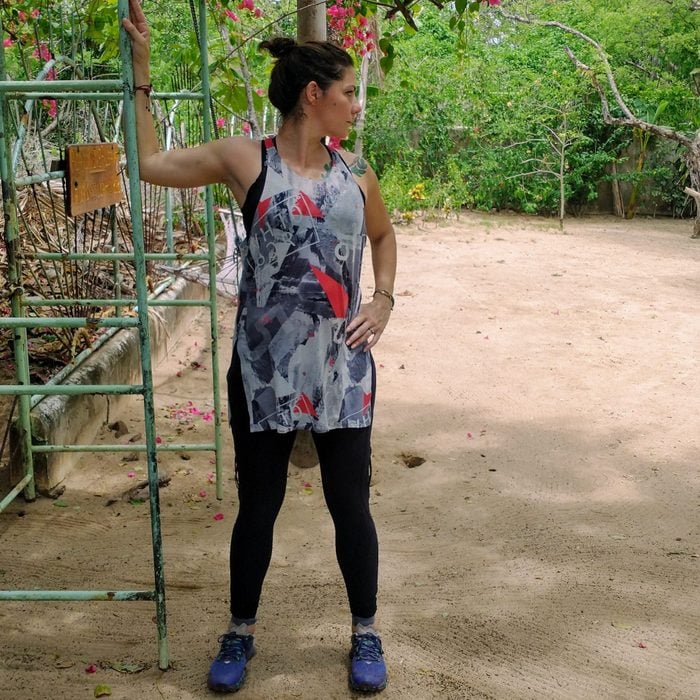
Chest stretch: Do it when you’ve been sitting for more than 30 minutes
The chest stretch is another comfort stretch that can help reset posture after you’ve been sitting for a long time.
Most people have a tendency to sit with poor posture. You know the look: shoulders rounded, head and neck tilted forward, the upper back loose, and the chest tight. This chest stretch can help you return to a more upright position while loosening up those tight shoulders and pecs.
Stand with your feet hip-distance apart next to a door frame. Your body should be perpendicular to the door, with your right shoulder closest to the frame.
Lift your right arm until your elbow is in line with your shoulder. Your right elbow should be bent 90 degrees and touching the door frame. Grab the door frame with your right hand.
Take a breath in and engage your core. As you exhale, rotate your left shoulder back until you feel a slight stretch across your chest and right shoulder.
Hold the position for 20 to 30 seconds, then switch sides. Complete a total of three sets per side.
(Related: The Types of Stretching Fitness Experts Recommend—and One They Avoid)
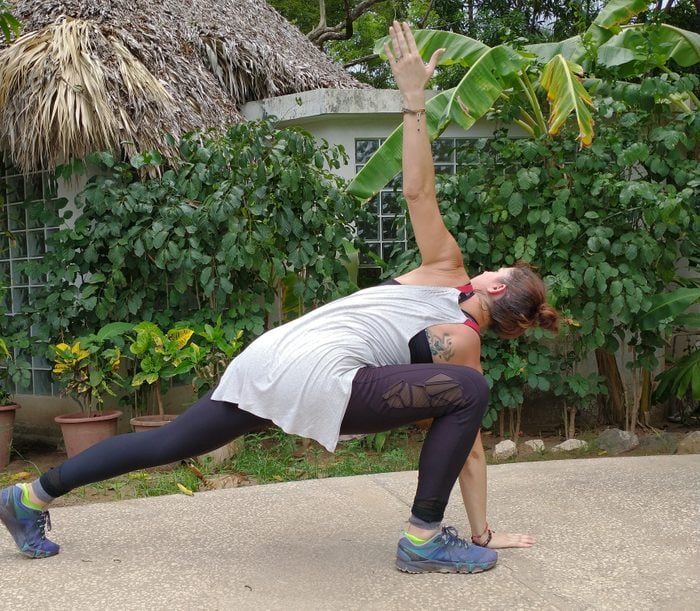
High plank mountain climber to rotation: Do it before a workout
This multi-joint dynamic stretch is the perfect movement to perform after a warm-up but before you dive into your workout. It targets almost every major joint and muscle group, which helps mentally and physically prepare you for exercise.
Typically, you’ll perform the stretch from a high plank position (that’s the start of a push-up). If that’s too tricky, have no fear. You can modify the exercise based on your strength and flexibility. For instance, you can start on an incline, with your hands on a bench or against a wall.
Start in a high plank position on a mat: shoulders and palms aligned, and body supported by your palms and the balls of your feet. Engage your core and check your posture to make sure your body forms a straight line from the crown of your head to your heels.
Step your right foot forward, placing it flat on the ground to the outside of your right hand. Adjust your stride length based on your flexibility.
Take a breath in. As you exhale, reach your right arm out and up, twisting your right shoulder toward the ceiling as you look up.
Hold the position and breathe deeply for five seconds, then return your right hand to the ground.
Keeping your right foot where it is, immediately rotate to the opposite side, sweeping your left arm out and up.
Hold the position and breathe deeply for five seconds. Return your left hand to the ground. Step your right foot back to the starting position.
Perform the same series of movements on the left side: step your left foot forward, twist to left, and then twist to the right.
Complete two sets of 10 mountain climbers with rotations to each side.
(Related: 5 Stretches and Exercises for Shoulder Pain)
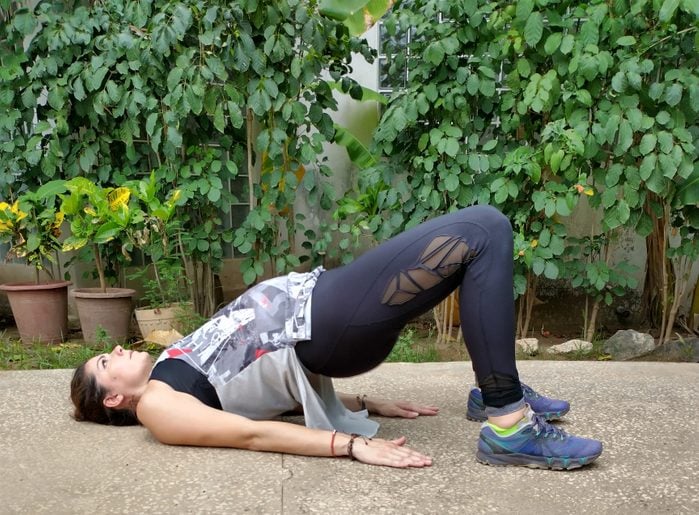
Pelvic bridge roll up: Do it before a workout
This stretch can activate your glutes (butt) and core, stretch your hips, and help improve spinal mobility. It’s another active stretch that’s helpful before a workout, particularly if you plan on targeting your glutes or core during your routine.
Lie on your back on a mat with your knees bent and your feet planted roughly hip-distance apart. Press your low back into the mat to help engage your core.
Take a breath in. As you exhale, engage your glutes and slowly roll your hips up off the mat. Lift your spine away from the mat, vertebrae by vertebrae, until your hips are fully extended. Your body should form a straight line from your knees to your shoulders.
Reverse the movement and slowly roll your hips back down to the mat. Focus on lowering yourself one vertebra at a time.
Complete two sets of 15 roll ups.
(Related: 3 Stretches That Are Good For Your Heart)
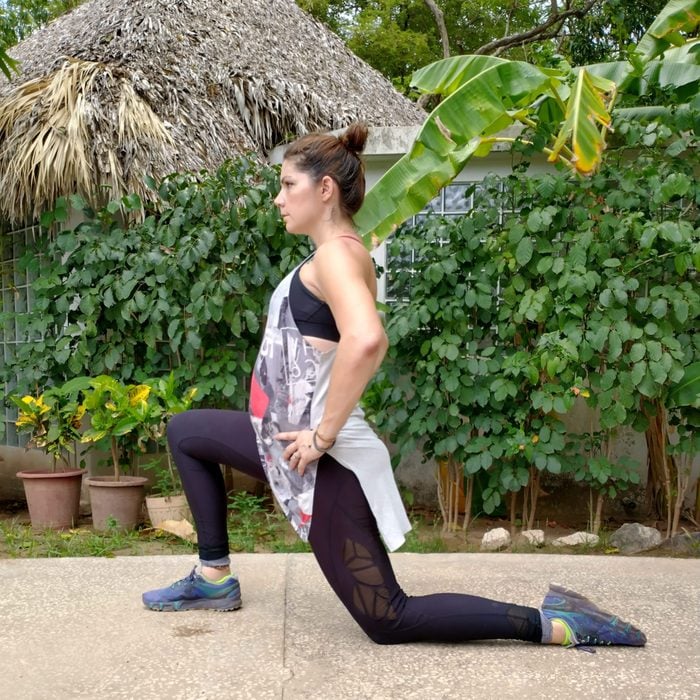
Kneeling hip flexor stretch: Do it after a workout
Years spent sitting (at your job, in your car, and on the couch) often leads to tight hip flexors and back pain. It can even change your gait.
Stretching your hip flexors on a regular basis—especially at the end of a workout, when your muscles and joints are warm and pliable—can improve hip mobility, reduce low back tension, and help improve overall movement.
Kneel on a mat with your right foot planted on the ground and facing forward, the knee and hip bent at a 90-degree angle. (It’s the same stance you’d take if you were about to ask someone to marry you.)
Press your hips forward, extending your left hip slightly until you feel a stretch at the front of your left thigh. Hold the position for 30 seconds, release for 10 seconds, then repeat.
Complete a total of four stretches to the left side before switching sides.
Next: 5 Moves to Do With a Resistance Band for a Full-Body Workout




